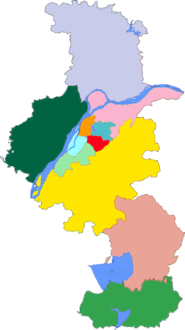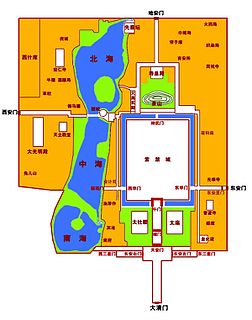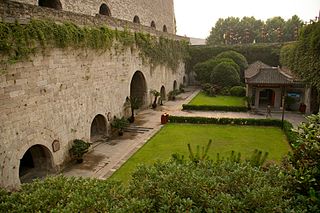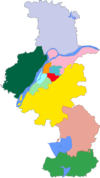| Wuchaomen Park (Chinese :午朝门公园) | ||||||||||||||||||||||||||||||
|---|---|---|---|---|---|---|---|---|---|---|---|---|---|---|---|---|---|---|---|---|---|---|---|---|---|---|---|---|---|---|
 | ||||||||||||||||||||||||||||||
| Location | 28 Yudao Road, Baixia District, Nanjing, China (鼓楼区广州路83号) | |||||||||||||||||||||||||||||
| Nanjing district map | ||||||||||||||||||||||||||||||
| ||||||||||||||||||||||||||||||
Wuchaomen Park (Chinese :午朝门公园) is a park located in Baixia District, Nanjing, China. The site once the forbidden grounds of a Ming Palace and has a palace gate dated from 1367, one of the few such gates that still exists in the city. Wuchaomen Park has a view over tree-lined Yudao road from the top of a grey-bricked structure. It has a reputation for saxophone playing and opera singing by local residents. Some visitors also practice tai chi or walk backwards in circles. [1]

Chinese is a group of related, but in many cases not mutually intelligible, language varieties, forming the Sinitic branch of the Sino-Tibetan language family. Chinese is spoken by the Han majority and many minority ethnic groups in China. About 1.2 billion people speak some form of Chinese as their first language.

Baixia was a district of Nanjing, the capital of Jiangsu Province, People's Republic of China. It has a population of 530,000 (2011) and a land area of 35 square kilometres (14 sq mi). By the side of Qinhuai River, Baixia District has a long history and culture. It is one if the downtown areas of Nanjing and has convenient transportation and economic prosperity. After infrastructure improvement, the area has become an elegant living environment furnishing full communication and functional information network capacity.
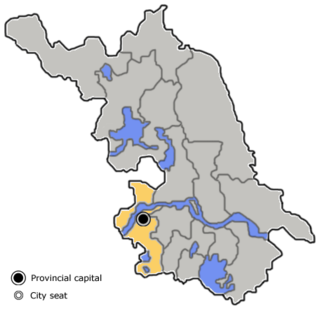
Nanjing, formerly romanized as Nanking and Nankin, is the capital of Jiangsu province of the People's Republic of China and the second largest city in the East China region, with an administrative area of 6,600 km2 (2,500 sq mi) and a total population of 8,270,500 as of 2016. The inner area of Nanjing enclosed by the city wall is Nanjing City (南京城), with an area of 55 km2 (21 sq mi), while the Nanjing Metropolitan Region includes surrounding cities and areas, covering over 60,000 km2 (23,000 sq mi), with a population of over 30 million.
The City of Nanjing has identified it as one of the top five parks in the city. Others are Mochou Lake Park, Xuanwu Lake, Qingliangshan Park and China Gate Castle Park. [1]
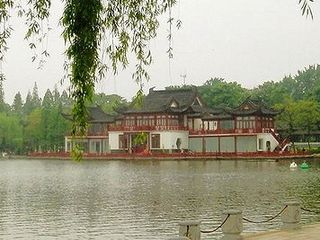
Mochou Lake is located west to Qinhuai River and Hanzhongmen Gate in Nanjing, China, inside Mochou Lake Park. The lake is named after Mochou, a legendary woman known for her beauty, versatility, virtue and loyalty. It was named Hengtang in ancient times, and also known as Stone City Lake. The lake park was owned by Zhu Yuanzhang, the first emperor of Ming Dynasty, and bestowed to his general Xu Da. Since then, it has become a famous garden best known for its two-storied Shenggi Pavilion. Within the park are other pavilions, gardens, pools and a stunning rock display. It is noted for its architecture, collection of carved antique rosewood furniture and calligraphies. Visitors can take boats allow through the lotus blossomed lake.

Xuanwu Lake is located in Xuanwu District in the central-northeast part of Nanjing, Jiangsu. It is near the Nanjing Railway Station and Ji Ming Temple. Five islands within the lake are interconnected by arched bridges. Within the park are temples, pagodas, pavilions, gardens, teahouses, restaurants, entertainment venues, a small zoo, and other attractions. Its main entrance is the Xuanwu Gate.
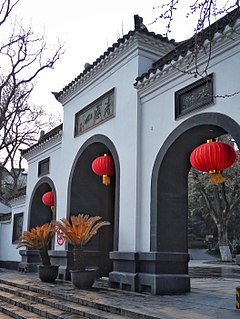
Qingliangshan Park (Chinese:, is a 73 hectares park located in the Gulou District, Nanjing, China. It sits on Qingliang Hill, which is more than 100 metres high and 4 kilometres in radius.
